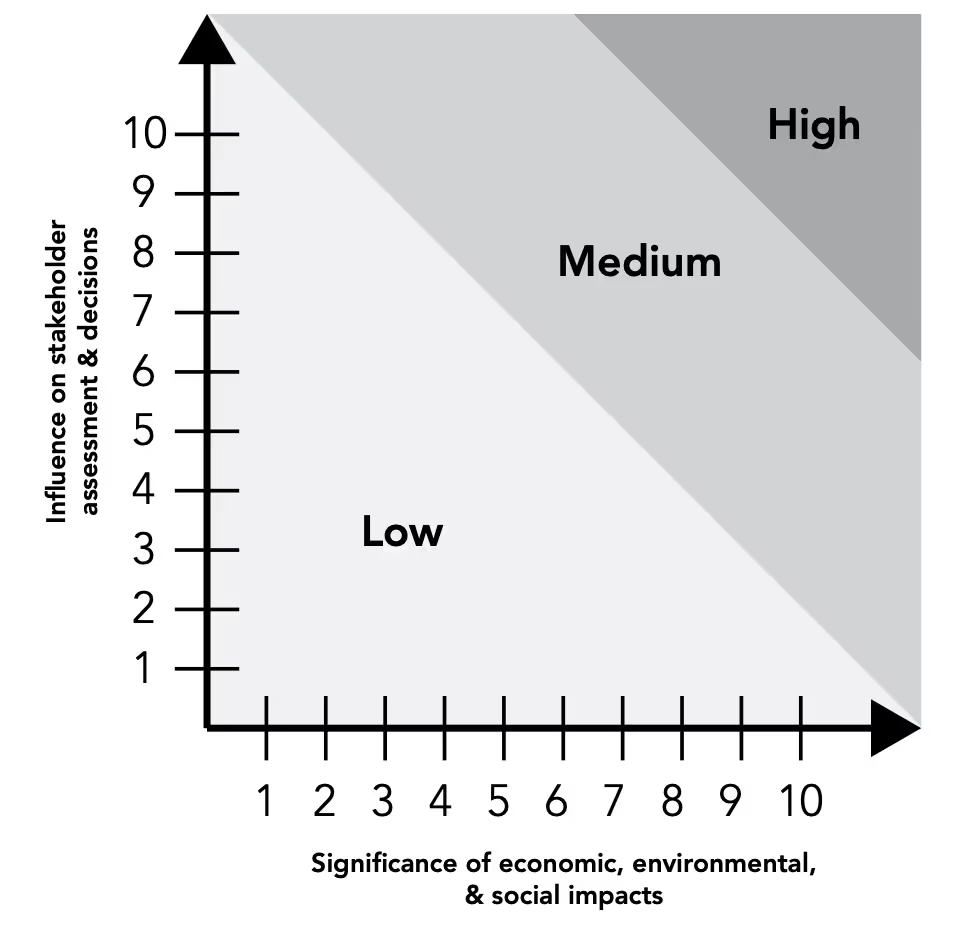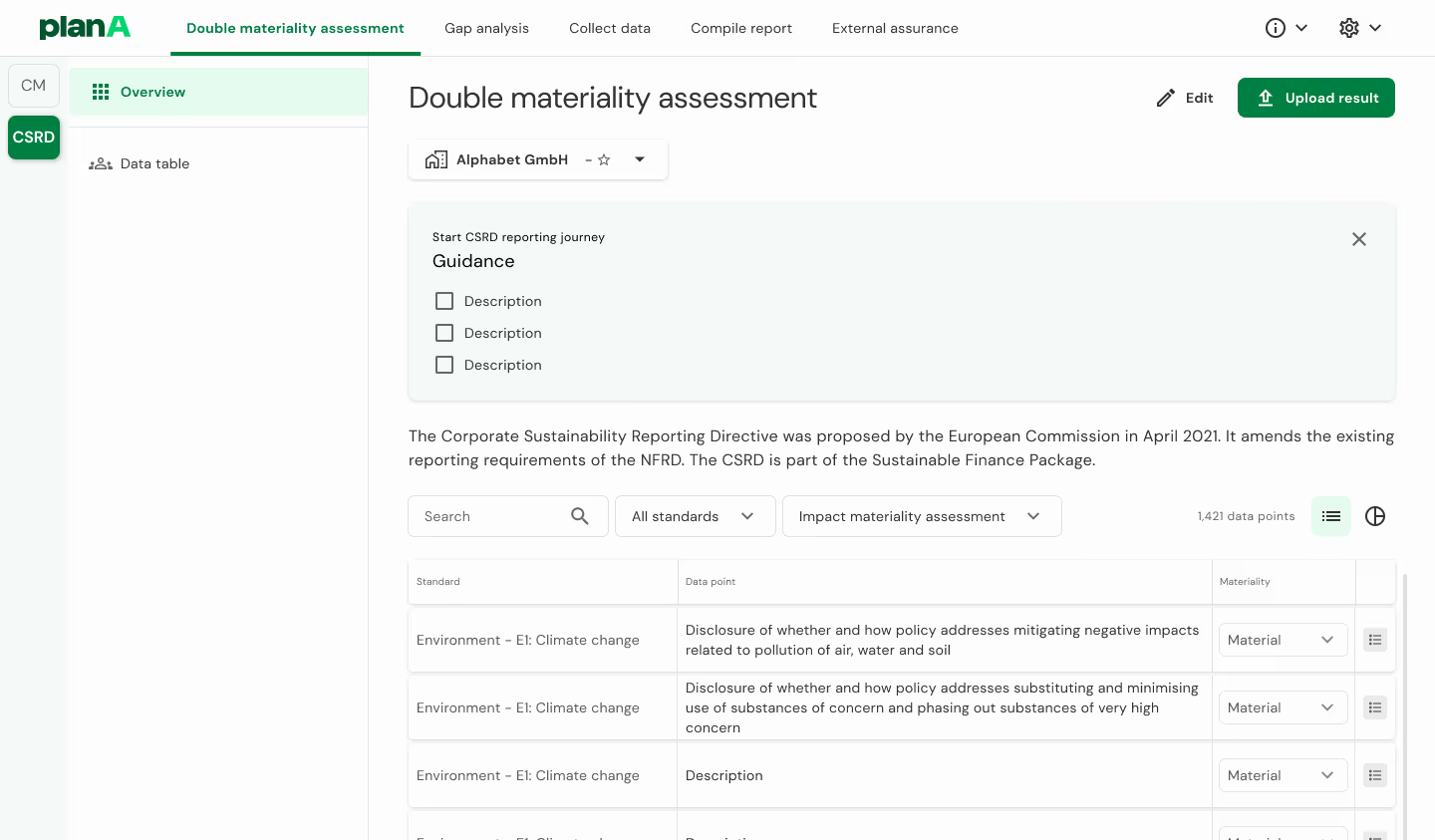In recent years, ESG (Environmental, Social, and Governance) considerations have become increasingly significant in the corporate world. By 2025, ESG-mandated assets are expected to make up nearly half of all professionally managed investments, amounting to approximately $35 trillion. Furthermore, 87% of CEOs now advocate integrating ESG metrics into regular corporate reporting, underscoring the shift towards sustainable business practices.
Companies can undertake various sustainability assessments to evaluate their environmental and social impacts: one crucial test is the materiality analysis, a key component of ESG operations. Materiality assessments, visualised through materiality matrices, help organisations identify and prioritise the most significant environmental, social, and governance issues on which the organisation has an impact and might be impacted, as well as its potential opportunities. This article explores the importance of materiality assessments and matrices, their implementation, and how they contribute to achieving sustainability goals.
What is a materiality assessment?
In line with GRI (Global Reporting Initiative) standards and recommendations, sustainability reports must assess and reflect the company's significant economic, environmental, and social impacts to align sustainability strategy with stakeholders' expectations and inform decision-making.
A sustainability assessment is a strategic sustainability tool used to understand and prioritise the ESG issues or opportunities relevant to a company by engaging with internal and external stakeholders. This process is often visualised through a materiality matrix. Each problem or opportunity is evaluated according to the company's and stakeholders' points of view. Key issues from both perspectives are then included in the Corporate Social Responsibility (CSR) reports.
Difference between materiality matrix and materiality assessment
The materiality matrix helps structure the ESG approach, simplify reporting, and strengthen the company's credibility in the eyes of investors. It demonstrates that the organisations underwent an analysis and evaluation of ESG material issues, which investors find reassuring considering the financial risks related to ESG. The matrix itself is a visual representation of the materiality assessment results, hence a way of disclosing how issues are ranked to justify both the sustainability strategy and reporting.
Therefore, materiality matrices and assessments are distinct yet complementary components of ESG operations:
- Materiality assessments are comprehensive processes that identify and prioritise ESG issues
- Materiality matrices, on the other hand, are the visual representation of the results from the assessment, mapping the importance of these issues to stakeholders and the business
Importance of materiality assessments and matrices
A study by Geldres-Weiss et al. (2021) shows that materiality assessments and matrices help transform traditional business models into sustainable ones and incorporate innovation, notably through better decision-making and reporting.
Strategic planning and decision-making
Materiality matrices are essential tools in strategic planning and decision-making. By identifying and prioritising the significant ESG challenges, these tools enable businesses to meet stakeholder expectations and regulatory requirements.
This helps ensure that the company’s efforts focus on areas with the most substantial impact. For example, a case study of Unilever demonstrates the benefits of using a materiality matrix: the company has integrated key ESG topics within its business model and strategy, which is considered best practice. Unilever has established specific KPIs around critical issues that are assessed as part of its business performance. Notably, the CEO’s bonus is tied to achieving particular ESG targets, such as reducing carbon emissions and improving health and well-being.
By embedding ESG considerations into its core operations, Unilever has seen enhanced brand reputation, improved stakeholder relations, and long-term financial performance. This materiality analysis approach has allowed Unilever to address ESG issues effectively while pushing innovation and growth.
Regulatory compliance and reporting
Materiality matrices also help improve transparency in reporting and meet regulatory requirements, particularly with frameworks such as the GRI, the Corporate Sustainability Reporting Directive (CSRD) and the Sustainability Accounting Standards Board (SASB). Indeed, a well-constructed matrix enables companies to focus on and disclose meaningful and compliant information with these standards. This enhances the credibility of their reports and builds trust with stakeholders by demonstrating a commitment to transparency and accountability.
Furthermore, it’s crucial to disclose the materiality assessment process and be transparent about how the results were reached. This transparency in the process is as important as the assessment itself, as it provides stakeholders with a clear understanding of the company’s decision-making and prioritisation of ESG issues.
Critical components of a materiality matrix
Stakeholder engagement
Engaging key stakeholders in the materiality assessment is crucial for ensuring that the identified ESG issues reflect the perspectives and priorities of those who are affected by or have an influence on the company. Effective stakeholder engagement involves consulting with a diverse group, including employees, customers, investors, suppliers, community members, and ESG experts. This process helps gather valuable insights and build trust.
Issue identification
To identify relevant ESG issues to include in the materiality matrix, companies should implement a systematic process as follows:
- Start by reviewing internal and external documents: Examine past materiality matrices, internal reports, and policies, as well as external frameworks like GRI and SASB and peer company reports.
- Analyse industry trends: Use industry reports and market research to monitor industry developments, regulatory changes, and technological advancements.
- Remember to consider stakeholder feedback: You can do so through surveys, interviews, and consultations to gather perspectives and ensure the materiality matrix reflects stakeholders' priorities.
Additionally, common ESG issues to keep an eye on and address might include the following:
- Climate change and carbon emissions
- Resource management
- Labour practices and human rights
- Community engagement
- Corporate governance
Prioritisation criteria
The criteria for prioritising ESG issues involve assessing their significance to the business and stakeholders. Key factors include:
- Financial impact
- Regulatory implications
- Stakeholder interests and concerns
- Long-term sustainability goals
For example, a company might prioritise reducing carbon emissions due to their contribution to climate change, high stakeholder concerns, and regulatory pressures.
Visualisation methods
A good visualisation of the materiality matrix is essential for clarity and communication. Here's how to do it with diagrams and visual examples:
- Use heat maps to illustrate the significance of various issues
- Scatter plots show the relationship between business impact and stakeholder concern
- Bubble charts can depict the magnitude of the different problems
Steps to develop a materiality matrix
Identify and engage stakeholders.
To develop a materiality matrix, start by identifying and engaging stakeholders comprehensively. This involves recognising key stakeholders and implementing best practices from academic literature on stakeholder engagement to ensure a balanced representation of perspectives and expectations.
Essential stakeholders include external and internal actors, such as staff and employees, the board of directors, senior leadership (internal), customers, investors, NGOs, local community members, faculty, and students (external).
Map the value chain
A crucial first step is mapping the value chain, which is the series of steps a company takes to transform raw materials into the final product delivered to customers, encompassing production, distribution, and disposal. This process ensures consideration of the full impact of operations and all sustainability risks and opportunities linked to the business.
Identify and prioritise potential ESG issues
To identify ESG issues, companies should conduct precise risk analyses, review sector-specific sustainability reports, and consult reporting frameworks to pinpoint current or future key challenges. These issues should be ranked in order of importance by integrating stakeholder feedback and evaluating their impact on business performance.
Develop the matrix
There are three main methods to develop a materiality matrix.
The traditional Matrix: This method involves creating a two-axis matrix (see below) to prioritise topics based on their impact on business (X-axis) as rated by internal stakeholders and their importance to external stakeholders (Y-axis).
Each topic, such as energy consumption, waste management, air emissions, and water consumption, is assessed through average ratings from both stakeholder groups. This can be done simply with a 3-column table as follows:

The process includes plotting these ratings on the matrix and establishing a cut-off threshold to define high-priority topics, ensuring clarity in identifying key focus areas for the organisation's sustainability strategy.

Updated materiality matrix: This method maintains the two-axis structure but replaces the X-axis with the most impactful environmental, social, and economic topics identified. Internal and stakeholder responses are aggregated and plotted on the Y-axis. Similar to Method 1, a 3-column chart can be made as follows:

Here's what the matrix should look like:

Table ranking: This method prioritises topics by listing them by their relevance score. Scores across all criteria, including committee rankings and stakeholder feedback, determine the ranking of each topic. A defined threshold is then applied to identify and prioritise the most critical topics, ensuring strategic alignment with organisational sustainability objectives. Here's an example:

Review and update regularly
It is essential to regularly review and update the materiality matrix to reflect changes in the external environment and partners' expectations. Materiality assessments are living pieces, and stakeholders and business priorities can quickly change in evolving contexts (e.g., during pandemics, scandals, etc.). This practice ensures the company remains proactive in managing ESG issues and is aligned with long-term goals.
In conclusion, the materiality matrix is critical for companies willing to improve their ESG performances. Businesses can align their sustainability efforts with stakeholder expectations and regulatory demands by identifying and prioritising critical environmental, social, and governance issues. Regular updates to the matrix ensure continued relevance and effectiveness in sustainability strategy. Developing your materiality matrix will help you enhance transparency, accountability, and long-term value creation.

Schedule a call to see how Plan A’s Carbon Management Platform can streamline the materiality assessment process to ensure alignment with forthcoming regulations such as CSRD.



.jpg)




